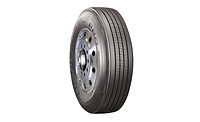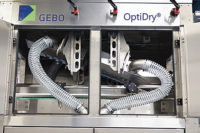Extending Tire Life
BY DAVID KOLMAN
Following a set of basic tire
maintenance procedures will lower per-mile tire costs through extended
tread life, fewer premature tire removals and better retreadability,
advises the Goodyear Tire & Rubber Co. These procedures include:
Determine proper inflation
levels for your application. The biggest influence on tire life is
inflation pressure because tires are designed to run at specific pressures
based on the total load. (This information can be found in tire load charts, available from tire manufacturers.) At normal
speeds, running tires at 20 percent under recommended inflation pressure
reduces tire mileage by 16 percent and fuel mileage by 2 percent.
Establish a good inflation maintenance program. Tire
pressure is difficult to maintain because tires naturally lose air over
time and leakage can occur through valve caps or through small punctures.
Air pressure should be checked at least once a week using a calibrated air
gauge.
Protect sidewalls from curb damage.
In-city driving and pick-up-and-delivery routes present many opportunities
for potential sidewall damage. Alert drivers to the importance of avoiding
sidewall impact and encourage drivers and technicians to inspect tires
regularly for sidewall wear and damage.
Keep vehicles properly aligned. Irregular tire wear is
most commonly caused by poor vehicle alignment. If tires are not running
straight ahead, accelerated tread wear occurs.
Mount tires correctly. The rounder or more concentric the
tire, the better it will wear. To keep tire
runout — a condition in which a tire or rim is out of round when
rolling — to a minimum, tires should always be mounted correctly on
the wheel. Ideally, the tires should be match-mounted to the wheel. Match
mounting tires on wheels is a process where a tire’s installed
position on the wheel is specifically selected to help minimize the final
combination’s forces and/or imbalance that can affect a
vehicle’s ride quality.
Learn to “read” tires. Regular inspections of
tires — both visually and by running a hand over the tread and
feeling for abnormalities — can provide a lot of useful information
and catch wear trends before they have done too much damage. If corrected
early enough, bad wear patterns can be countered and tire life extended.
Rotate tires. Tire rotation promotes even tread wear and
can net a lot of extra miles in tread life. Drive tires should be rotated
between forward and back positions at least once to even out wear. Rear
tires of a tandem axle typically will wear more quickly than the forward
positions. Some drive tires will also develop heel and toe wear. This is a
condition where the tread on the leading edge of the tire is round, like
the heel of a foot, and the tread on the trailing edge is pointed, like a
toe. Heel and toe wear can be evened out by reversing the drive tires
direction.
Replace tires with matching ones. For optimum tread wear,
tires need to be as alike as possible across the same positions. If a tire
must be pulled due to irregular wear or a road hazard, it should be
replaced with a tire that matches the existing one. On dual assemblies, the
outside diameters and tread depths should be as close as possible. A good
rule of thumb is no more than 2/32-inch tread depth difference between
duals. It’s also best to have the same tread design on both positions
of an axle.
Check and replace worn wheel and suspension components. These can be the
hidden enemies of tire life. A wheel bearing that is not properly torqued
can cause irregular tire wear. Worn shock absorbers can create depression
wear on treads and an early trip to the retreader or scrap pile. To prevent
irregular tire wear, replace shock absorbers and other suspension
components on a set schedule rather than waiting
until they fail.
Keep good tire records and use the data wisely. Because every fleet is different, there are no hard
and fast formulas for tire management. In fact, copying another
fleet’s practices may do more harm than good. To manage tires most
efficiently, regular collection and analysis of data on tires — such
as tire inflation pressures, wear trends and tire
mileage at removal — is critical. BI

